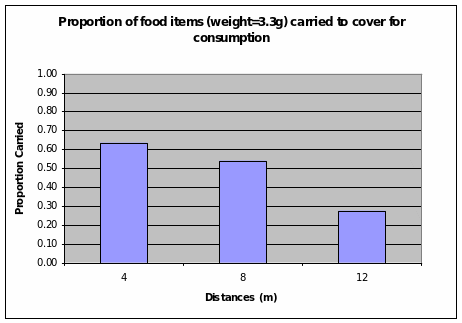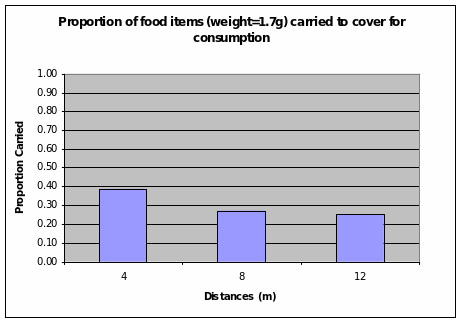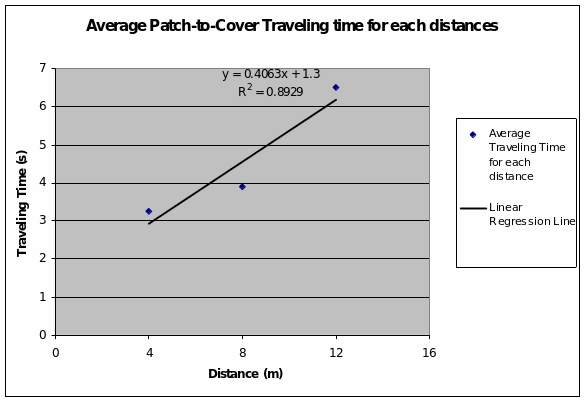Introduction
Big cities are inhabited by not just humans. Different wild animals have become a part of the urban environment and were forced to adapt to it. Some of them have done this particularly well. This study takes a broad look at the behavioral ecology of black squirrels that are very common animals in big North American cities.
Most animals are influenced by environmental patterns and have to respond to them. These patterns impact the risk of predation as well as foraging efficiency. Everybody had noticed that sometimes squirrels eat their food right away, and sometimes carry it to safety before eating. This experiment hypothesizes that black squirrels are trading off their rate of energy intake for the risk of predation.
A study that focused on examining foraging efficiency – predation risk trade-off in grey squirrel claimed that the maximal energy efficiency is reached when the animal consumes the food immediately, whereas carrying of the food to the safety of a tree provides a minimal risk of predation for the grey squirrel (Lima et al., 1985).
Optimal foraging theory has been causing a lot of commotion in the scientific world of behavioral ecology, and many of its hypotheses have been proven in laboratory conditions. Two paradigms have been dominating in this theory. The first one is the prey choice, and the second is the patch use (Krebs, 1978; Krebs, Stephens, & Sutherland, 1983; Pyke, Pulliam, & Charnov, 1977). In the patch use paradigm, the forager is being faced with food containing well-defined patches (Parker & Stuart, 1976). It is us to the forager to decide whether to leave the current patch and to spend additional time to travel to another, possibly better patch.
The animal needs to be fit. Alimentary energy intake is by far not the only source of fitness for black squirrels. Other not less essential factors that determine fitness are avoidance of predators and animal’s reproductive needs.
The model of optimal foraging ideally points to the fact that the food item is consumed immediately upon encountering, as transportation of the food to another place is wasteful in terms of time and energy. However, if the animal senses that it is a potential subject of predation, it will carry the food to cover and consume it there. Of course, such actions would waste time and energy, but eating the food in a safer place decreases the risk of being predated.
According to Milinski & Heller (1978), the animal would attempt to find a compromise between carrying or staying when it considers the potential risk of predation and compares it to the energy intake.
This study performs an analysis of how foraging considerations and predation risk influence the behavior of black squirrels. These animals use trees as a hideout, as well as for feeding. However to obtain food, black squirrels must cover significant distances in their search for food, and when they are looking for something to eat, there might not be any trees around.
In this study, I suspect that whether the black squirrel stays and eats the food, or runs to the nearest tree to consume it depends also on the size of the food, which impacts the “handling time” of the item. The following information uses a mathematical framework for measuring the tendency of staying or carrying the food item.
Methods
The experiment was conducted during October and November 2007 in a large open field (about 100×150) bordered by a line of mature sugar maple (Acer saccharum) and Bur oak (Quercus macrocarpa)
The food items were located at a certain distance from the cover (tree). There was no search time, as the patches were easily found and discrete.
Food patches were placed at 8 m distance away from the line of the tree each day for 1 week before the start of the study. Four to six squirrels were expecting food at the site every morning. An experiment was conducted almost every day (except rainy days) from 6:45-8:15 am.
We have used the crackers as food items. The weight was estimated from the “Nutrition Facts” table on the package (“per 6 crackers (20g)”). One cracker is 3.3g and the half piece is 1.7g.
Squirrels never buried crackers so we can observe the handling process.
Patches were white paper plates (23cm in diameter). In each study period, 3 patches were placed at the same distance from the cover. Five crackers were placed on each plate. Inter patch distance was 3 meters and the patches were replenished whenever necessary. There were three various distances to cover provided for the experiment: 4, 8, and 12 meters. The food items were two sizes – one whole piece (3.3 g), and a half-piece (1.7 g).
Combinations of food sizes and distances to cover were randomly applied for each day for a total of six days. No same combination was available on two successive days. Six combinations of item size and distances to cover were applied on the later 2 weekends (Saturdays and Sundays).
The main object this study focused on was how the squirrels balance their foraging efficiency with possible potential predation risk. For this purpose six combinations of “food item size-distance to cover” have been implemented and used. ANOVA test was used to determine the mean proportion of items carried to cover.
A linear regression model was used to analyze the correlation between distance to cover and traveling time. The correlation coefficient was used to indicate the relation direction and strength between two random variables. Correlation referred to the departure from the independence of two variables.
Levene’s test of equality of error variances was used to test the null hypothesis that the error variance of the dependent variable is equal across groups.
Sometimes the squirrels stayed and consumed (handled) the food item, and sometimes they carried the item to cover. The item size and distance combinations on successive days were randomized in a way that they followed no set of order. On one study day, just one combination of item size-distance was available. The food items were most of the time consumed near the patch or carried to the nearest tree for cover. We considered that the squirrel carried an item to cover if it carried it half or more of the distance to it. In the contrariwise case, we considered that the squirrel stayed at the food patch. Figure 1 demonstrates the proportion of food items that weighed 3.3 grams that were carried to cover for consumption. Figure 3 shows the average patch to cover traveling time for each distance used in the experiment.
It did not make any sense to measure the traveling time from cover to patch, as usually, the squirrels did not run directly from cover to patch. They were sniffing around for a while. Hence the ideal traveling time was considered to be 2×
Another aspect that should be mentioned is that when squirrels carried the food back to cover (tree) they usually tasted it on the way there. In some cases, they took the food item in an unpredicted direction, and/or were scared by some predators like dogs, or a group of gulls. The data obtained during such conditions were discarded. SPSS analysis was performed for analyzing the relation of item sizes to distances and the proportion of carried items.
Results
For analyzing the size-distance combination effect on the proportion carried, four-day data was used (all 6 combinations were applied to each day). Figure one shows the mean proportion of items that weighed 3.3 grams that were carried by the squirrels to cover. It appears that the highest proportion (0.6325) of taking the food to cover was in the case of a 4-meter distance to cover. A somewhat lower proportion (0.5650) of carrying the food to cover was in the 8-meter cohort. The lowest mean (0.2850) proportion of carrying the food item to cover was when the food was placed 12 meters away.
Concerning the results obtained with the 1.7-gram food item (Figure 2), we have observed a similar tendency. The four, eight, and twelve-meter distance obtained mean proportion carried values of 0.6325, 0.5650, and 0.2850 accordingly.
After performing the ANOVA test to analyze the proportions of carrying the food item at each one of the three distances from cover, we have asked ourselves, whether the mean proportion carried value depends on the food item size and at the same time distance to cover. The SPSS analysis has revealed that the differences are statistically significant (p<0.001). The relation of item size and distance to cover to the mean proportion carried was discovered (Figure 4). Table 2 illustrates the test of between-subject effects, analyzing the significance of item size, distance, and combination of item size and distance, revealing a significance level of 0.000 for all three, proving the fact that these factors are significant in terms of influencing the mean proportion carried.
The relation of traveling time and distance was also analyzed. The linear regression model (Figure 3) illustrates an increasing trend of the average traveling time with increasing distance. Table 1 demonstrates the descriptive statistics according to the dependant variable being the proportion carried. It also reveals the standard deviation of each value.
Discussion
At the provided distance from the tree (cover), the black squirrel had more chances of carrying larger 3.3-gram items to its cover before consuming the food. For any size – large or small, it was less likely that the squirrel would carry the item back to the cover with increasing distance. These results are not surprising as they correspond to the hypothesis made earlier. It appears that this experiment had proved the fact that while foraging away from cover black squirrels are trading off energy considerations against the risk of being preyed upon.
We have not observed many cases when the squirrel had walked directly from their cover to the food item patch. Instead, they frequently sniffed around the site where the food was placed. Hence measuring the time it took for the squirrel to get from the cover to the food patch was not worthwhile. Consequently, we have considered the ideal traveling time to be 2 × patch-to-cover travel time.
We also were forced to discard a lot of data for the reason that the squirrels sometimes grabbed the food and took off in unpredicted directions. Another thing that forced us to reject the obtained data was when the animal took the food to take it to cover and tasted it on the way, as well as if the squirrel was scared by different kinds of predators like dogs, cats, or maybe a group of gulls.
If the squirrels would attempt to simply minimize the predation risk in all of the cases, we would observe that the food item, disregarding its size is taken to the tree for cover at the distance of 4, 8, and 12 meters. On the other hand, if the squirrels would be worrying solely about energy consumption and waste, they would consume the food item immediately, not taking it to cover and the distance-food item size combination would not matter.
Our experiment had revealed that the black squirrels were considering the cost of carrying the food item, and it was less probable that the squirrel would carry the food to cover if this cost was great. The distance from cover was considered an important factor, as great distance led to greater time that the animal had to be exposed to predators. We believe that the distance from cover has a two-fold effect. One of those effects is the time exposed to predation, and the other encloses the probability of escaping in case the squirrel is attacked by another animal.
The above implies the higher chances of the squirrel staying at the patch, as they are being drawn closer to the cover. According to the obtained results we have also assumed that the higher distance there is between the food patches and the cover, the more exposure time to predators, and it makes less probability for the squirrel to remain at the patch to consume the food item. This probability of escaping in case of an attack may explain that some squirrels have carried the food item only partially.
Unfortunately, our study had not considered any effects of competition and scramble, as these effects most likely decrease the squirrel’s food gain. If the squirrel that is foraging is joined by another squirrel their level of competition significantly increases. It should be mentioned that such a possibility might influence the tendency of staying at a patch of one single squirrel, as this would enable the animal to consume more food before the appearance of a competitor. We have also not considered a factor of dominance between the black squirrels, as the squirrel which has a higher dominance rank is more likely to stay at the food patch than the less dominant one.
Even if we were to consider the assumption about the dominant and subordinate squirrels true, we cannot claim for sure that there is a difference between the foraging efficiency in these two groups. However, dominant squirrels may be trading off energy consumption efficiency and the risk of being predated somewhat differently, compared to the subordinate ones.
Conclusion
Optimality can be applied to animal behavior, in particular, foraging behavior. Optimal foraging theory describes the application of optimality to the foraging behavior in detail.
This study had hypothesized and proven the fact that black squirrels can balance their energy intake and risk of being predated in a way that optimally fits the current situation. It is clear that the more energy is gained by the forager, the more it benefits from the foraging and the more chances of avoiding starvation.
However, the results of this experiment do not claim that the black squirrels are literal optimizers. The tendency of maximizing the foraging efficiency may be explained by the fact that the animals are being guided by simple rules that enable them to draw near the optimal solution. A consequence of this view is that the animals may perform badly in conditions that are very different from those that have been responsible for selecting the animal’s rule over evolutionary time. This distinction between the optimality analysis and the rule that the animal uses is no more than the traditional distinction between functional (ultimate) and causal (proximate) explanations. In other words, optimality theory is not a theory about the immediate control of behavior, but a theory about the factors that influence its evolution. Behavioral ecologists use the statement “animals maximize reward rate” as an abbreviation for the statement “natural selection has evaluated foraging behavior in terms of resulting reward rate.”
References
Krebs J. R., Kacelnik A., & Taylor P. (1978). “Test of optimal sampling by foraging great tits”. Nature, 275, 27-31.
Krebs J. R., Stephens D. W., & Sutherland W. J. ( 1983). “Perspectives in optimal foraging”. In A. H. Brush & G. A. Clark Jr. (Eds.), Perspectives in ornithology (pp. 165-221). Cambridge, England: Cambridge University Press.
Milinski, M. & Heller, R. (1978). Influence of a predator on the optimal foraging behaviour of sticklebacks (Gasterosteus aculeatus L.) Nature, London, 275, 642-644
Parker G. A., & Stuart R. A. (1976). “Animal behaviour as a strategy optimizer: Evolution of resource assessment strategies and optimal emigration thresholds”. American Naturalist, 110, 1055-1076.
Pyke G. H., Pulliam H. R., & Charnov E. L. (1977). “Optimal foraging: A selective review of theory and tests”. Quarterly Review of Biology, 52, 137-154.




Table 1. Descriptive Statistics. Dependent Variable: ProportionCarried
Table 2. Tests of Between-Subjects Effects. Dependent Variable: ProportionCarried
a R Squared =.967 (Adjusted R Squared =.958)